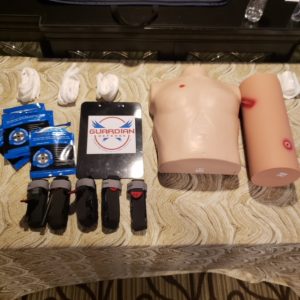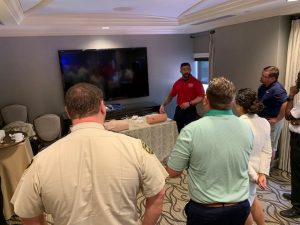Civilian trauma care training has been a hot topic in schools and workplaces over recent years. The rise in popularity is most likely due to the paranoia surrounding potential active shooter situations. Active threat or active shooter occurrences are still statistically low occurrences. Yet, it is important to be prepared for such active shooter events. A greater possibility is being inflicted with a life-threatening wound from an accident, or other form of violence when an active shooter situation occurs.
If your school, workplace or place of worship has already participated in active shooter training; and/or you have invested in trauma care kits as part of your preparation for an active shooter incident, we strongly recommend the proper and professional training on the use and function of the items in the kits.
What is Civilian Casualty and Trauma Care Training?
Casualty and Trauma Care allows civilians to provide assistance and aid to those inflicted with life-threatening wounds until medical personnel can treat the wounds.
- Items like tourniquets, when applied properly, can temporarily restrict blood loss from the affected artery.
- With proper training, civilians who are not medical professionals, military personnel or first responders can aid in saving their own life or someone else’s life.
Why is Civilian Trauma Training Important?
In the instance of an accident, or worst-case scenario of an active shooter incident or active threat in the workplace or a school, civilians are the first responders.
When seconds count, it is vital to begin aiding the wounded individual(s).
During an active shooter incident or active threat, time can especially be strained.
First responders will be rushing to the scene. Law enforcement’s first and primary objective is to
- eliminate the threat,
- potentially passing over and not treating wounded individuals until the threat has been resolved.
This means that YOU are the true first responder in this active shooter or active threat scenario. Will you be able to treat the injured and help save lives?
What do Casualty and Trauma Care Preparations Include?
Casualty and Trauma Care preparations include TWO Things:
- Trauma care kits for your organization
- Training regarding how to use the kits effectively
What is a Trauma Care Kit?

You can buy a trauma care kit, or an Individual First Aid Kits (IFAKs) from reputable companies online. Most companies have made their own kits, or will allow you to build your own.
At minimum, Guardian Defense recommends your IFAKs include:
- A Combat Application Tourniquet (also nicknamed a “CAT tourniquet”) (Generation 7)
- A Hemostatic dressing or gauze (Quik Clot or Celox)
- A Chest seal (Halo or Asherman)
IFAKs often include additional items such as an emergency bandage or gauze, gloves, and trauma shears.
These items can all be purchased separately.
How Many Do You Need for Your School or Workplace
The exact number of kits needed depends entirely on your budget. With this in mind, we have three recommendations.
For large budgets:
- 1 kit per classroom/office
- 1-3 kits per gym/auditorium/meeting room/other large area where staff, students, or guests gather
- 1 for the nurse or per nurse (for schools)
For smaller budgets:
- 1-3 kits per gym/auditorium/meeting room/other large area where staff, students, or guests gather
- 1 for the nurse or per nurse (for schools)
- Buy tourniquets in bulk for every teacher, staff member, or employee to have on person or in their workspace.
For no or very limited budgets:
- Educate your staff on the importance of these life-saving items for not only work, but their family also. Encourage them to purchase at least a tourniquet on their own, if not an IFAK Kit and carry on-person or keep close by.
Should you place trauma care kits in hallways?
It is difficult to make a concrete “Yes” or “No” answer. We tend to lean towards “no,” with the understanding that every situation, school and workplace is different. In a perfect world, every classroom and office space would have an IFAK in that room. In the instance a life-threatening injury is due to an active threat, people may choose to isolate in a secured location such as a classroom or office, rather than in the hallway. This would make the trauma care kit accessible in the room and why we would recommend placing these items inside.
We also understand that there are endless scenarios where an IFAK in the hallway may be beneficial. Using our recommendations above based on the number of kits you have may help serve as a general baseline.
“Velcro or hang the kits in a manner where staff can easily and quickly remove them under stress and with possibly wet or bloody hands.”
The Importance of Training with these Items
IFAKs are useful in a wide variety of situations: not just in the very low likelihood of an active shooter. It can be used for accidental cuts with a knife while cooking, a car accident, or other unpredictable events. Comprehensive civilian trauma care training with the use of these items can be the difference between life and death.
Do You Have Trauma Kits and Need Training?

If you have invested in IFAKs or related items such as tourniquets for your business, school, or place of worship, it is essential that you learn how to properly use these items by undergoing civilian trauma care training.
Our Trauma and Casualty Care for Civilians (TACCC) course is a 3-hour session developed for staff to learn how to administer self-aid to life-threatening wounds on the body.
Through a mix of lecture-style presentation and hands-on demonstration, participants will learn how to utilize tools typically found in trauma kits. We also add a component on how to make improvised tourniquets/materials when these items are unavailable.
Contact us today for more information on this important course.

